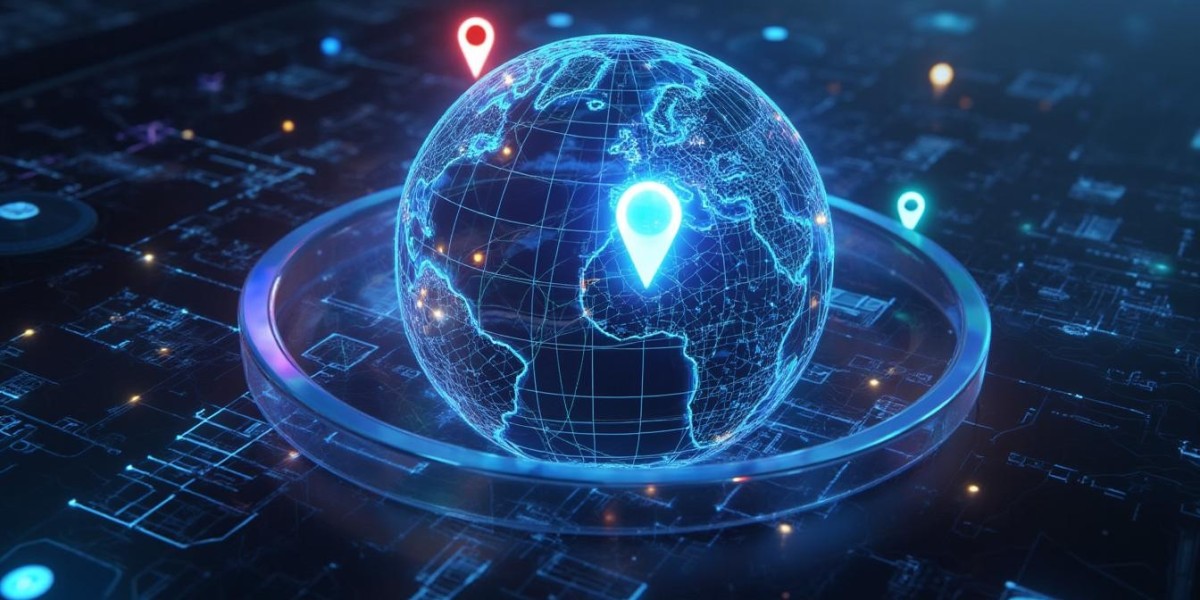GEO Services in Healthcare: Enhancing Patient Care and Logistics
In the rapidly evolving healthcare sector, technology plays a crucial role in improving patient care and streamlining operational processes. Among the innovations shaping healthcare today, GEO Services stand out as a powerful tool that enhances logistics, patient safety, and real-time decision-making. With the ability to collect, analyze, and interpret location-based data, healthcare organizations are increasingly leveraging GEO Services to ensure patients receive timely care, optimize supply chains, and improve access to healthcare facilities.
At Adomantra, we recognize the transformative potential of GEO Services in healthcare. From emergency response coordination to patient tracking, appointment management, and equipment delivery, the integration of geospatial data is revolutionizing the way healthcare providers operate. In this blog, we explore how GEO Services are enhancing patient care and logistics, the challenges they address, and how they contribute to better outcomes.
What Are GEO Services in Healthcare?
GEO Services refer to location-based services and technologies that collect and process geographical information to support various functions. In healthcare, this means using tools such as GPS tracking, geographic information systems (GIS), remote sensing, and mapping analytics to assist in patient monitoring, resource allocation, and transportation logistics.
Healthcare providers can use GEO Services for purposes such as:
Locating nearby hospitals and clinics for emergency situations.
Tracking medical equipment and supplies in real-time.
Coordinating ambulance routes for faster response times.
Monitoring the spread of diseases geographically.
Identifying healthcare service gaps in underserved areas.
By harnessing location data, healthcare providers can ensure resources are allocated efficiently, response times are reduced, and patient outcomes are improved.
The Role of GEO Services in Enhancing Patient Care
1. Real-Time Emergency Response
In emergency situations, every second counts. GEO Services enable healthcare providers to respond faster by providing precise location data. Ambulances equipped with GPS tracking can identify the shortest routes, avoid traffic congestion, and reach patients in critical condition more quickly.
For example, a patient experiencing a cardiac arrest needs immediate medical intervention. GEO-enabled dispatch systems ensure that the nearest ambulance is alerted and provided with real-time traffic data, allowing it to arrive faster, increasing the chances of saving lives.
2. Remote Patient Monitoring and Telemedicine
With the rise of telehealth, healthcare providers increasingly rely on GEO Services to monitor patients who are not physically present in a hospital. For patients living in rural or remote areas, location-based tools can help ensure they receive timely medical consultations and care.
Through wearable devices and mobile health apps, healthcare teams can monitor vital signs and track patient movements. GEO Services alert medical professionals if a patient deviates from a care plan or enters a high-risk area, allowing proactive intervention.
3. Disease Surveillance and Management
Geospatial data is essential in tracking the spread of infectious diseases like COVID-19, influenza, and other public health threats. By mapping disease outbreaks and patterns, healthcare authorities can deploy targeted interventions, such as vaccination drives or quarantine zones.
This data-driven approach ensures that healthcare resources are directed where they are most needed and enables better forecasting to prevent future outbreaks.
4. Personalized Care and Accessibility
GEO Services can help healthcare providers tailor treatments based on location-specific factors such as climate, air quality, or environmental hazards. For instance, a patient with respiratory conditions may benefit from alerts about local pollution levels.
Additionally, geospatial analytics can identify areas where healthcare access is limited, enabling governments and organizations like Adomantra to expand services and infrastructure to underserved populations.
GEO Services and Healthcare Logistics
Effective logistics are vital to ensuring that healthcare facilities are well-equipped and that patients receive timely treatments. GEO Services help optimize logistics by improving supply chain management, resource allocation, and facility planning.
1. Optimizing Supply Chains
Medical supplies, including pharmaceuticals, vaccines, and surgical instruments, need efficient distribution networks to ensure they reach hospitals and clinics on time. GEO Services help in:
Tracking shipments in transit.
Forecasting demand based on population density.
Managing warehouse locations to reduce delivery times.
By reducing bottlenecks and improving inventory management, healthcare providers can prevent supply shortages and ensure critical resources are always available.
2. Enhancing Equipment and Asset Management
Hospitals rely on numerous assets such as ventilators, diagnostic machines, and ambulances. GEO Services allow administrators to track the location and usage of these assets in real-time, ensuring that equipment is deployed where it is needed most.
For example, during peak periods or in disaster situations, real-time asset tracking enables healthcare teams to quickly identify available resources and allocate them efficiently.
3. Streamlining Patient Transportation
Patient transfers between facilities require careful planning to avoid delays. GEO Services assist in optimizing ambulance dispatch and hospital bed availability. By integrating patient location data with hospital occupancy rates, providers can coordinate transfers more effectively, improving patient experience and reducing unnecessary hospital stays.
4. Disaster Preparedness and Response
Natural disasters, such as earthquakes or floods, disrupt healthcare logistics. GEO Services provide predictive analytics and real-time monitoring that help prepare for such events. Emergency shelters, medical camps, and supply routes can be planned based on geographic risk areas, ensuring healthcare services remain uninterrupted.
Challenges in Implementing GEO Services in Healthcare
Despite the numerous benefits, integrating GEO Services into healthcare operations comes with challenges:
1. Data Privacy and Security
Handling sensitive patient information requires strict compliance with privacy laws such as HIPAA. Healthcare providers must ensure that location data is securely stored and shared only with authorized personnel.
2. Infrastructure Limitations
In regions with poor internet connectivity or outdated infrastructure, implementing GEO Services can be difficult. Investment in technology and training is essential to ensure that healthcare staff can utilize these tools effectively.
3. Data Accuracy and Integration
The effectiveness of GEO Services depends on accurate and up-to-date information. Integrating geospatial data with electronic health records (EHRs) and other healthcare databases can be complex but is crucial for successful outcomes.
4. Costs and Resource Allocation
Setting up and maintaining geospatial systems requires significant investment in hardware, software, and training. Organizations must weigh these costs against the long-term benefits of improved patient care and logistics.
How Adomantra is Driving GEO Services Adoption in Healthcare
At Adomantra, we are committed to empowering healthcare providers through innovative solutions that leverage GEO Services for better patient outcomes. Our approach includes:
Developing customized location-based systems tailored to healthcare operations.
Offering data analytics solutions that integrate with existing hospital management software.
Training healthcare staff to use geospatial tools effectively.
Ensuring data security and compliance with regulatory frameworks.
Partnering with governments and NGOs to expand healthcare access in underserved areas.
By combining technology expertise with healthcare knowledge, Adomantra helps organizations harness the full potential of GEO Services to enhance patient care and streamline logistics.
The Future of GEO Services in Healthcare
The future of healthcare is increasingly interconnected, and GEO Services will play a pivotal role in transforming the sector. Emerging technologies such as artificial intelligence (AI), the Internet of Things (IoT), and 5G connectivity are set to further enhance the capabilities of location-based services.
Here’s what the future holds:
Predictive healthcare: Analyzing location trends to anticipate patient needs and manage resources before crises occur.
Smart ambulances: Integrating real-time data feeds to guide emergency response teams dynamically.
AI-powered disease control: Using geospatial data to model infection pathways and deploy preventive measures.
Personalized health insights: Providing location-specific alerts related to environmental risks, nutrition, or exercise.
Healthcare systems that adopt GEO Services early will be better equipped to serve patients efficiently, reduce operational costs, and respond swiftly to emergencies.
Conclusion
GEO Services are redefining healthcare by providing location-driven insights that enhance patient care, improve logistics, and support data-driven decision-making. From emergency response coordination to supply chain optimization, geospatial tools are empowering healthcare providers to deliver timely and effective services.
With the guidance and expertise of Adomantra, healthcare organizations can seamlessly integrate GEO Services into their operations while ensuring privacy, accuracy, and efficiency. As technology advances, the role of geospatial solutions in healthcare will only expand, enabling smarter, faster, and more accessible care for patients worldwide.
Frequently Asked Questions (FAQ)
1. What are GEO Services in healthcare?
GEO Services in healthcare refer to location-based technologies and systems that collect, analyze, and interpret geographical data to support healthcare operations. These services help improve patient care, streamline logistics, manage equipment, and optimize emergency responses by providing real-time location information and mapping tools.
2. How do GEO Services improve patient care?
GEO Services enhance patient care by enabling faster emergency responses through GPS tracking, supporting remote patient monitoring, and providing personalized health insights based on environmental factors. They also help healthcare providers monitor disease outbreaks, allocate resources effectively, and ensure patients in remote areas have access to timely medical interventions.
3. How are GEO Services used in healthcare logistics?
In logistics, GEO Services assist in tracking medical supplies, managing inventory, optimizing ambulance routes, and ensuring efficient patient transfers between healthcare facilities. They also help hospitals plan disaster response, manage medical equipment, and forecast supply needs based on geographic patterns.
4. Can GEO Services track medical equipment in real-time?
Yes. GEO Services allow healthcare providers to monitor the location and usage of medical equipment, such as ventilators, diagnostic devices, and emergency transport units. Real-time tracking ensures that resources are deployed quickly and efficiently, reducing delays in treatment.
5. How does GEO Services support disease control and prevention?
By analyzing geographic data, healthcare organizations can map the spread of diseases, identify hotspots, and predict outbreaks. This information helps public health officials implement targeted interventions such as vaccination drives, isolation protocols, and awareness campaigns, ensuring timely action to control diseases.
6. Are GEO Services safe and compliant with healthcare regulations?
When implemented with the right protocols, GEO Services are safe and comply with healthcare privacy regulations such as HIPAA. Healthcare providers must ensure that patient data is encrypted, shared only with authorized personnel, and integrated with secure systems to protect sensitive health information.
7. What challenges are associated with using GEO Services in healthcare?
Common challenges include ensuring data privacy, integrating geospatial data with existing healthcare systems, addressing infrastructure limitations in rural areas, and managing costs associated with technology deployment and staff training. Despite these challenges, the benefits often outweigh the risks when implemented properly.
8. How can GEO Services help in rural healthcare delivery?
In remote and underserved areas, GEO Services help track patient movements, coordinate telemedicine sessions, and ensure that emergency response teams can reach patients quickly. Location data also assists in identifying healthcare access gaps, allowing organizations like Adomantra to expand services where they are most needed.
9. What role does GEO Services play in disaster management?
During natural disasters, GEO Services provide real-time maps of affected areas, track resource availability, and help coordinate medical teams and supplies. These tools ensure that emergency response is efficient, shelters are optimally located, and medical camps are set up where they are needed most.
10. How can healthcare providers start using GEO Services?
Healthcare organizations can begin by integrating GPS tracking, GIS mapping, and location-based data analysis into their existing systems. Partnering with technology providers like Adomantra, they can ensure secure implementation, staff training, and regulatory compliance while gradually expanding the use of geospatial solutions to meet specific needs.
11. Will GEO Services reduce healthcare costs?
Yes. By improving logistics, minimizing delays, preventing resource wastage, and optimizing staff deployment, GEO Services help reduce operational costs. Efficient supply chain management and better decision-making also lead to cost savings in both routine care and emergency situations.
12. Can GEO Services help personalize healthcare treatments?
Absolutely. GEO Services analyze factors such as local air quality, climate, and environmental risks, allowing healthcare providers to personalize treatment plans. For instance, patients with allergies or respiratory diseases can receive alerts based on local pollution levels, improving their overall health management.
13. How are GEO Services integrated with other healthcare technologies?
GEO Services can be integrated with electronic health records (EHRs), telemedicine platforms, patient monitoring devices, and predictive analytics tools. This integration provides a comprehensive system that allows healthcare providers to access patient information, location data, and health trends from a single platform.
14. What is the future of GEO Services in healthcare?
With advancements in AI, IoT, and 5G networks, GEO Services will become more powerful and predictive. Future applications include smarter emergency response systems, AI-driven disease control models, and location-based personalized health alerts. Healthcare organizations that adopt these tools early will be better equipped to manage patient care and logistics efficiently.
15. How does Adomantra support healthcare organizations using GEO Services?
Adomantra provides tailored solutions for healthcare providers, including data integration, training, security compliance, and analytics support. By helping organizations implement GEO Services safely and effectively, Adomantra ensures that healthcare systems are optimized for faster, smarter, and more efficient care delivery.







